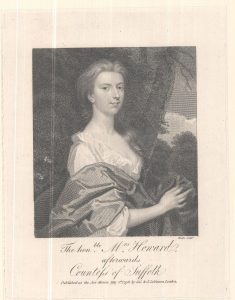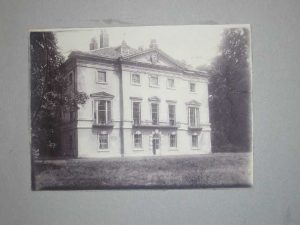Marble Hill House, Twickenham – [Local History Notes: 10]
Henrietta Howard (c.1688-1767), for whom Marble Hill House was built, was described by her friend Horace Walpole as:
“of a just hight, well made, extremely fair, with the finest light brown hair … remarkably genteel, and always well drest with taste and simplicity …Her face was regular and agreeably rather than beautiful …She was discreet without being reserved; and having no bad qualities, and being constant to her connections she preserved uncommon respect to the end of her life.”
In 1706, when not yet 18 years old, she married Charles Howard (1675-1733), youngest son of Henry Howard, 5th Earl of Suffolk. It was to prove an unhappy union. She and her husband gained an introduction into the Court of Hanover and, after the succession of George I in 1714, both were given posts in the royal household, Charles being made Groom of the Bedchamber to the king and Henrietta a Woman of the Bedchamber to Princess Caroline, wife of the Prince of Wales (the future George II). After becoming estranged from her husband, Henrietta became the Prince’s mistress.
In 1723 the Prince of Wales made a financial settlement on Henrietta which gave her some measure of independence from her husband. The persons nominated by the Prince as trustees to administer these funds on her behalf were the Earl of Ilay – later 3rd Duke of Argyll – and Robert Britiffe.
By July 1723, a plan of Henrietta’s proposed villa in Twickenham was near completion and a few months later a site was chosen for the house. The acquisition of the Marble Hill estate was a gradual – and probably – expensive process. It sometimes involved the buying-out of several interests in the same piece of land. The present park measures 66.5 acres, but at the beginning of the 18th century, it was divided between a number of owners many of whose holdings measured little more than half an acre.
Alexander Pope
On behalf of Mrs Howard, in 1724 Lord Ilay acquired 11.5 acres in a ‘shot’ of land called Marble Hill. Some of her many friends – including Charles Mordaunt (3rd Earl of Peterborough), Allan Apsley (1st Earl Bathurst) and, chiefly, Alexander Pope – supplied ideas for the layout of the grounds. The planning itself, however, was the work of a professional landscape gardener – Charles Bridgeman. Bridgeman was the Royal Gardener to both George I and George II and created for the latter the Round Pond (1728) and the Serpentine (1731). During the 1730s, he also designed Queen Caroline’s gardens at Richmond Lodge. (See Richmond Lodge – [Local History Notes: 39]).
In June 1724, Lord Ilay engaged Roger Morris (1695-1749) as architect. [He should not be confused with Robert Morris of Twickenham, the author of Lectures in Architecture (1734-6) and Select Architecture (1755)]. Morris was one of a new generation of men at that time who combined their talents as architect with a sound practical knowledge of building and a shrewd business sense. The building was probably completed in 1728 or 1729.
In 1731, Charles Howard became 9th Earl of Suffolk on the death of his elder brother, Edward, with Henrietta as his Countess. As a peeress she could no longer hold the post of Woman of the Bedchamber and so accepted the position as Mistress of the Robes, but in 1734, she resigned from the post – having apparently offended George II in some way.
Berkeley
In 1735, now a widow as Charles had died in 1733, Henrietta married the Hon. George Berkeley (1693?-1746), the younger brother of James, 3rd Earl of Berkeley, Member of Parliament for Dover 1718-1734 and Heydon (Yorkshire) 1734-1746. This was destined to be a much happier marriage for Henrietta than her first. The couple divided their time between Marble Hill and their house in Savile Row. The grounds were extended during this period, but not without some difficulty – Alexander Pope was instrumental in acting as mediator in the exchanges between Henrietta and the somewhat obstinate Vernon family who owned neighbouring land which she needed to acquire in order to fulfil an obligation to the local tenants. The tenants had agreed to the closure of a 12 foot track which crossed Marble Hill at one point and to which, up to that time, they had had right of way. Their agreement to the closure was made on condition that the track would be replaced by an extended terrace track along the river bank. In order to extend the terrace sufficiently however, it was necessary to acquire land owned by the Vernons which lay on either side of Marble Hill Park. The difficulties were not fully resolved until 1745, after which she had acquired the existing lease of all the land bordering the river. In 1756 Henrietta’s brother, John Hobart, 1st Earl of Buckinghamshire, died and she inherited 24 acres and the house known as Little Marble Hill which adjoined her land on the eastern side that he had bought in 1751.
 Henrietta moved permanently to Marble Hill after the death of her second husband in 1746, but retained the Savile Row property. She expanded the grounds yet further and in 1750-51 made alterations to the villa under the supervision of the architect Matthew Brettingham. According to an account written in 1760, a series of grottos were built and in 1983, the remains of one were found after part of the lawn near the river subsided – no evidence has yet been found of any others. Partly through the influence of Horace Walpole, another fanciful building was erected in the park in about 1758. Called The Priory of St. Hubert, it was dedicated to the patron saint of hunting, it was a gothick fantasy, possibly made of wood, designed by Richard Bentley. According to the inscription on a drawing of The Priory by Bentley, it was pulled down after Henrietta’s death on 26th July 1767.
Henrietta moved permanently to Marble Hill after the death of her second husband in 1746, but retained the Savile Row property. She expanded the grounds yet further and in 1750-51 made alterations to the villa under the supervision of the architect Matthew Brettingham. According to an account written in 1760, a series of grottos were built and in 1983, the remains of one were found after part of the lawn near the river subsided – no evidence has yet been found of any others. Partly through the influence of Horace Walpole, another fanciful building was erected in the park in about 1758. Called The Priory of St. Hubert, it was dedicated to the patron saint of hunting, it was a gothick fantasy, possibly made of wood, designed by Richard Bentley. According to the inscription on a drawing of The Priory by Bentley, it was pulled down after Henrietta’s death on 26th July 1767.
In her will, she stipulated that:
“all the household goods and furniture which shall be in or belonging to … Marble Hill …at the time of my decease shall go along with the said house as Heir Looms and be held and Enjoyed by the person and persons who shall from time to time be intitled to the possession of my said House.”
Henrietta’s heirs and executors would have liked to sell Marble Hill and invested the purchase money in a less complicated estate but, owing to the provision in her will, they had no legal right to do so and were thus only able to let the property. Marble Hill came into the possession of her nephew, John Hobart, 2nd Earl of Buckinghamshire, who occupied it until his death in 1793. In 1771, he had added 4 acres to the south-west corner of the park and was probably responsible for dividing the long gallery into 2 rooms.
Under the terms of Henrietta’s will, the estate then passed to her great-niece, Henrietta Hotham (d. 1816). She was rated for Marble Hill in 1794. Mrs Maria Fitzherbert, the morganatic wife of George IV, is listed as a ratepayer in April 1795, but she was only there for a short time – less than a year – after which Miss Hotham continued to let the house to tenants.
Peel
George Robert, 5th Earl of Buckinghamshire, inherited the estate on Miss Hotham’s death. He sold it in 1824, breaking the entail created by Henrietta. The purchaser was Timothy Brent, an army agent who was living at Little Marble Hill and continued to do so after selling Marble Hill, in 1825, to General Jonathan Peel, younger brother of Sir Robert Peel, the Prime Minister, under whom Jonathan served as Surveyor General of the Ordnance.
Jonathan Peel used the grounds of Marble Hill for rearing racehorses and growing hay – one of his horses, Orlando, won the Derby in 1844. He had the old stables demolished and the present block built on the west side of the park. The small lodge at the north-west entrance was probably built at the same time. In 1877, he made the property into a freehold estate – before it had been held by the owners as copyhold tenants of the Manor of Isleworth – Syon or as lessees. Peel remained at Marble Hill until he died in 1879 and his widow lived there till her death in 1887. At his death Jonathan Peel’s personal estate was given as under £35,000. Marble Hill and Little Marble Hill were left to his wife to use until her death, whereupon they were to be sold and the proceeds to be divided into seven and given to his children or their heirs.
County Councils
The threatened development of the estate by William Cunard and his three sons – who bought it in about 1888 and wanted to demolish the house and build an estate of suburban houses – caused strong public opposition, chiefly on the grounds of its damaging effect on the view from Richmond Hill. (See The View from Richmond Hill – [Local History Notes: 30]). A conference was held in July 1901, attended by representatives of several local authorities and preservation societies. As a result the London, Surrey and Middlesex County Councils, the Richmond Corporation and the Twickenham Urban District Council, together with certain private charities and individuals, agreed jointly to purchase the estate for £72,000. The London County Council, as the principal contributor, agreed also to undertake the future care of the property. The estate was formally conveyed to them on 1 August 1902 and the park was open to the public on 30 May 1903. The Greater London Council, which succeeded the LCC in 1965, carried out extensive and painstaking alterations to the exterior and interior in 1965-6, mainly intended to eliminate the inappropriate changes made since the 18th century and to restore the original appearance of the house.
Further reading
Borough of Twickenham / Twickenham 1600-1900: people and places. Local History Society (Paper no. 47. 1981)
English Heritage / Marble Hill: restoration of the gardens and park. 1989
Walpole, Horace / Letters. (Different editions). There are many references to Marble Hill and Henrietta Howard in these letters.
More information on other places and people of interest in the London Borough of Richmond upon Thames is available from the Local Studies Library & Archive.
